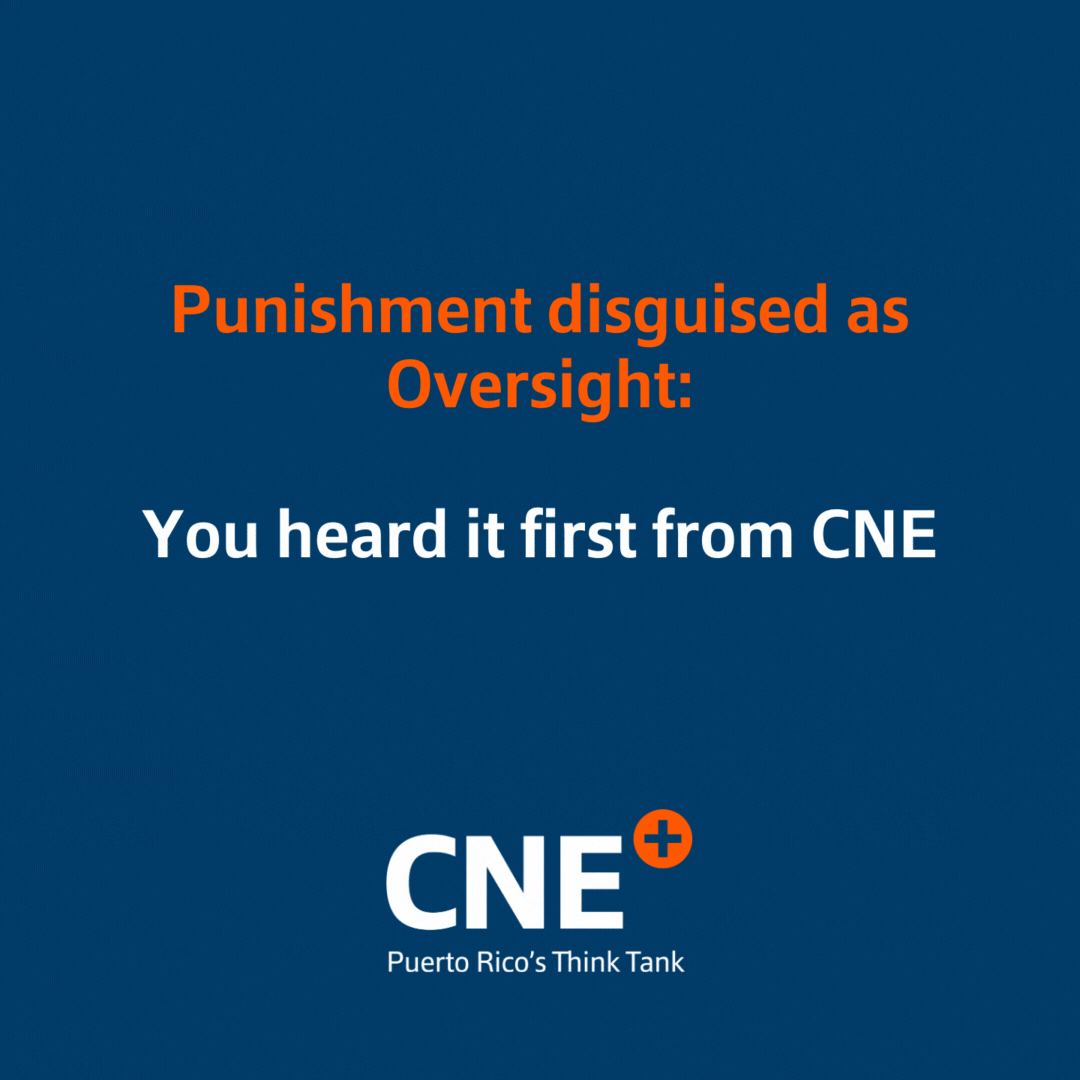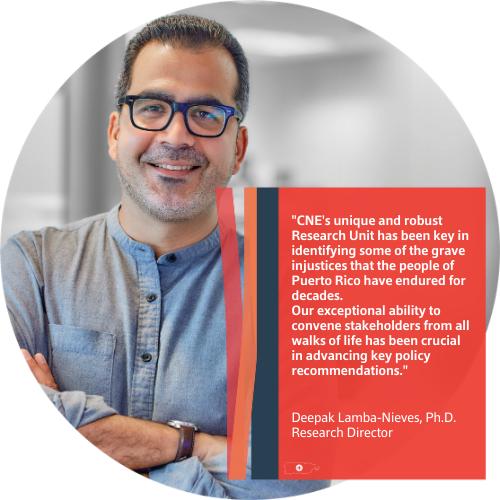
Published on April 29, 2021 / Leer en español
We continue to transform our newsletter to meet the demands of our times.
Starting May 2021 we will concentrate our efforts on a monthly publication.
Thank you for your constant support and readership!
In This Issue
This week, Rosanna Torres analyzes the recent report released by the U.S. Department of Housing and Urban Development’s Inspector General, which describes the Trump administration’s shenanigans in disbursing hurricane relief aid to Puerto Rico. Then, Sergio Marxuach provides a brief analysis of the role of federal funds in the new Fiscal Plan for Puerto Rico, certified by the FOMB.
Our Data Snapshot presents a quick update on the status of CDBG-DR funding for Puerto Rico. In the On Our Radar section we take a brief look at new metrics for a green global economy; the relationship between COVID-19 and industrial policy; and the factors affecting labor supply and demand in the United States.
We close with a brief note from our editor on the debate about work requirements for women who receive government benefits stirred by a recent proposal to provide an almost-universal child allowance to help families with dependent children.
Insights + Analysis from CNE
Oversight or Punishment?
By Rosanna Torres, Director – Washington, D.C. Office

Last week, the Office of the Inspector General of the U.S. Department of Housing and Urban Development (HUD) released a 45-page report which detailed the multiple instances when the political leadership in the Office of Management and Budget, a critical control center within the Executive Office of the President, purposefully delayed processes to release disaster aid. It was appalling for many to hear how the federal government intentionally dragged its feet in assisting Puerto Rico. As I read through it, however, it felt more like a coherent explanation to the many obstructions those of us advocating for funds had long encountered.
While it is fair to suggest there are opportunities to ensure better funding and investment decisions in the aftermath of a disaster, increased federal intervention on its own is not sound policy. First, because it chews up the available resources designed to address needs, but because it also adds more unnecessary layers of bureaucracy into an already complex process. As we’ve said in the past and reiterate now, punishment should certainly not be disguised as oversight.

Federal Funds Anchor New Fiscal Plan
By Sergio M. Marxuach, Policy Director
The Fiscal Oversight and Management Board (“FOMB”) for Puerto Rico certified a new fiscal plan for the central government on Friday, April 23. The new Fiscal Plan, just like the others, is based on four core elements: (1) budget consolidation (spending cuts and revenue increases); (2) structural reforms; (3) debt relief; and (4) federal funding for disaster relief and COVID-19 assistance. What’s new this time is the magnitude of federal funding. According to the FOMB, Puerto Rico will be receiving approximately $110 billion in federal funds over the next ten years. This amount would exceed Puerto Rico’s artificial, transfer price-inflated GDP of approximately $100 billion.
Data Snapshot
Current Status of CDBG-DR Funds

Source: Fiscal Oversight and Management Board, Commonwealth’s Plan of Adjustment, 8 March 2021
Between September 2017 and June 2019, Congress appropriated approximately $20.3 billion in Community Development Block Grant (“CDBG-DR”) funds for disaster relief and mitigation activities related to Hurricanes Irma and Maria. The usual process for disbursing these funds is somewhat cumbersome. As shown in the table above, after Congress appropriates the money, the Department of Housing and Urban Development (“HUD”) has to publish a notification in the Federal Register. The intended beneficiary then proceeds to draft an Action Plan for the use of the funds, in accordance with the published regulations. If and when the Action Plan is approved by HUD, then the parties need to execute a Grant Agreement to allow the expenditure of funds in accordance with the terms of the Action Plan.
In the case of Puerto Rico, however, it took HUD almost two years to publish the requisite notice in the Federal Register regarding the use of some $8.3 billion for mitigation activities. We strongly suspected this delay was a racist, punitive action taken against Puerto Rico by the Trump administration, disguised as “oversight” by the federal Office of Management and Budget. A recent piece in the Washington Post confirms our suspicions.
In contrast, the Biden Administration has moved rapidly to unlock this funding, announcing on April 19th that the Grant Agreement for these $8.3 billion will be executed soon and the money will be obligated and spent shortly thereafter on much-needed mitigation projects.
Team Spotlight
CNE’s work is driven by extraordinary individuals who help Puerto Rico design a path for sustainable economic growth. We want you to meet the people that are part of the CNE Team. In this section, we provide a glimpse of what motivates and fires our work every day.

On Our Radar...
![]() New Metrics for a Green Global Economy – President Biden’s announcement of a zero-emissions target for 2050 as a way of tackling greenhouse gas pollution and pushing clean-energy economic sectors in the US has been a most welcome development in the international community. Europe has been seeking to lead the global drive towards a green economy for a while, and leading think tanks like the Brussels-based Institute for European Environmental Policies have started developing new metrics to actually measure progress not only in terms of economic goals but in terms of environmental sustainability. Green subsidies would be measured alongside a country’s share of forest area, and green R&D alongside water bodies in good ecological status. You can access the forward-looking proposal here.
New Metrics for a Green Global Economy – President Biden’s announcement of a zero-emissions target for 2050 as a way of tackling greenhouse gas pollution and pushing clean-energy economic sectors in the US has been a most welcome development in the international community. Europe has been seeking to lead the global drive towards a green economy for a while, and leading think tanks like the Brussels-based Institute for European Environmental Policies have started developing new metrics to actually measure progress not only in terms of economic goals but in terms of environmental sustainability. Green subsidies would be measured alongside a country’s share of forest area, and green R&D alongside water bodies in good ecological status. You can access the forward-looking proposal here.
![]() COVID-19 and Industrial Policy – The slow roll-out of vaccination drives in Europe relative to countries like the US, the UK, and Israel has fueled a vivid debate over strategic manufacturing capacity, global supply chains, and Industrial Policy akin to the dialogue emerging in the US. Europe currently has 52 vaccine production sites and the European Medicines Agency recently put forth a series of recommendations to increase the region’s capacity to manufacture and supply COVID-19 vaccines. Think tanks like the Austrian Foundation for Development Research (OFSE in German) are promoting a longer-view discussion and are pushing for reshoring manufacturing facilities (both of end-products and inputs), diversifying supply chains (in terms of suppliers and regions), and aggressively increasing Research & Development investments. The topic impinges on Puerto Rico, whose pharmaceutical sector could benefit from the global push for increased pharma & medical supplies strategic capabilities. Two of OFSE’s recent papers can be found here and here.
COVID-19 and Industrial Policy – The slow roll-out of vaccination drives in Europe relative to countries like the US, the UK, and Israel has fueled a vivid debate over strategic manufacturing capacity, global supply chains, and Industrial Policy akin to the dialogue emerging in the US. Europe currently has 52 vaccine production sites and the European Medicines Agency recently put forth a series of recommendations to increase the region’s capacity to manufacture and supply COVID-19 vaccines. Think tanks like the Austrian Foundation for Development Research (OFSE in German) are promoting a longer-view discussion and are pushing for reshoring manufacturing facilities (both of end-products and inputs), diversifying supply chains (in terms of suppliers and regions), and aggressively increasing Research & Development investments. The topic impinges on Puerto Rico, whose pharmaceutical sector could benefit from the global push for increased pharma & medical supplies strategic capabilities. Two of OFSE’s recent papers can be found here and here.
![]() Labor Supply and Demand – According to data from the Bureau of Labor Statistics, total employment in the U.S. is about 9 million jobs lower than in February 2020, just before the pandemic. Yet, many business owners claim to be struggling to hire new workers. Neil Irwin explores some of the reasons behind this disconnect in this analysis for the New York Times. Specifically, he points to the following factors as reasons that could explain this perceived gap between labor supply and demand: health concerns about COVID-19, expanded unemployment benefits, the low wages that prevail in some service sectors, being needed at home to take care of children or elderly relatives, and the desire to reconsider career options after a lousy year.
Labor Supply and Demand – According to data from the Bureau of Labor Statistics, total employment in the U.S. is about 9 million jobs lower than in February 2020, just before the pandemic. Yet, many business owners claim to be struggling to hire new workers. Neil Irwin explores some of the reasons behind this disconnect in this analysis for the New York Times. Specifically, he points to the following factors as reasons that could explain this perceived gap between labor supply and demand: health concerns about COVID-19, expanded unemployment benefits, the low wages that prevail in some service sectors, being needed at home to take care of children or elderly relatives, and the desire to reconsider career options after a lousy year.
Note from the Editor
The Biden Administration’s proposal to provide an almost-universal child allowance to help families with dependent children has brought to the surface a long-simmering debate, between those who support work requirements for women who receive these benefits and those who don’t.
As Emily Badger and Claire Cain Miller pointedly argue in this analysis for the New York Times, “American mothers have always been sorted and divided — deemed worthy of aid or not — by race, by class, by marital status, by what their husbands do, by whether they’ve had too many children or not enough.” The implication being that it is a good thing when white, middle and upper-class, married mothers stay home and take care of the kids, but when “Black women attempt to stay home and care for their children, if they don’t have the means or the husband to do so, they’re vilified.”
These narratives go back centuries, as societies have tried to determine which families “deserve” help and which do not. Unfortunately, those decisions are more often than not made on anecdotic evidence, racist tropes, and classist stereotypes. That is why the Biden proposal is so controversial, at least in the United States. It does away with all this baggage and just provides help directly to families with children, no strings attached, no hoops to jump through. Therein lies the beauty of the policy: it is simple, easy to administer, and respects the individual dignity of the beneficiaries.
In contrast, attaching government benefits to work requirements sounds good in theory but is awful in practice. Work requirements are expensive to enforce, complicated to administer, oftentimes play up to racial stereotypes of doing away with “welfare queens”; and are usually extremely unfair. This last point is sometimes lost in the heated public debate. Advocates of these types of work requirements assume that taking care of children at home is somehow “not work”. They also presuppose that all women have access to high-quality, affordable child care, which is obviously not the case. Finally, and perhaps most important, they implicitly place a higher value on putting in more hours at a precarious job, than on family well-being and stability.
If we truly believe as a society that raising a family is the most important job any of us will ever have, then we should not, as conservative sociologist Brad Wilcox has argued, be pushing for “more measures that will put parents into the labor force than spend time with their kids. We need less workism and more familyism.”
